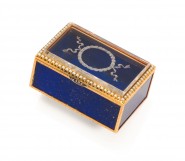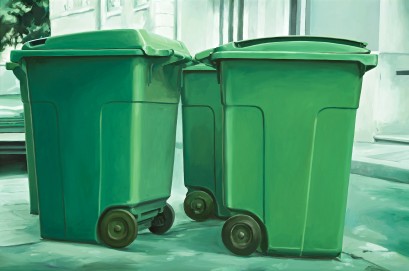Lot #77 - Stephen Bush
-
Auction House:Deutscher and Hackett
-
Sale Name:Important Australian & International Art
-
Sale Date:28 Aug 2013 ~ 7pm
-
Lot #:77
-
Lot Description:Stephen Bush
born 1955
Pomme De Terre #5, 1999
oil on linen
79.0 x 119.5 cm
signed, dated and inscribed verso on stretcher: Stephen Bush 1999 #5 -
Provenance:The John L. Stewart Collection, New York, purchased directly from the artist, c1999
-
Notes:One could argue that Stephen Bush’s paintings hover on the brink of obsession. Fascinated by unusual characters and objects, Bush has painted and repainted certain images, people, and things over decades, as if haunted by them. We have seen this with the repetition of the elephant, the caretaker, the explorer, and the tractor in his work, among other creatures. Why does Bush persistently resurrect his characters, or paint the same scene time and time again? In the opinion of American curator Liza Statton, the repetition ‘speaks to the physical and emotional rigors of the painting process’ and ‘Bush’s pure, unadulterated manual labour.’1 Perhaps this dedication also indicates the artist’s desire to get at some elusive truth lurking within the painting, something which is not so easily accessible (to viewer or artist) at first glance. ; ; One such motif that has captured Bush’s fascination since his earliest work is the potato. This fixation may be a result of the artist’s own agricultural background, growing up on a farm outside Colac, Victoria, and his long-term interest in humans’ cultivation and exploitation of nature. In Bush’s Venetian Red series there is a painting entitled Potato Art Museum (venetian red), 1993, in which the walls of a museum are curiously lined with images of potatoes. Several similar works followed, including Potato Museum, 1995, which also depicts a museum interior, at the centre of which sits a painting of three potatoes, ironically another work by Bush humorously named This Year’s New Pontiacs. ; ; Bush’s mysterious 1997–99 series Pomme De Terre is perhaps a more abstract rendering of the potato. This series evolved from the artist’s 1996 residency at Cité Internationale des Arts in Paris, where each day for the course of the residency he drew and then ate a potato. At the conclusion of the residency he threw all his potato drawings into a green wheelie bin, and this became the basis of this ambiguous series of paintings. As the audience, we are privy to none of this back-story, and thus we see no more than the tactile shape and colour of the rubbish bins. In this way, Bush demonstrates his concerns about post-colonial historical and landscape painting. That is; there is more, far more, to understanding history, then what we can tell from a picture. ; ; 1. Statton, L., ‘No consolation prizes’, in Stephen Bush: Gelderland, SITE Santa Fe, Santa Fe, New Mexico, 2007 exhibition catalogue ; ; LEAH CROSSMANOne could argue that Stephen Bush’s paintings hover on the brink of obsession. Fascinated by unusual characters and objects, Bush has painted and repainted certain images, people, and things over decades, as if haunted by them. We have seen this with the repetition of the elephant, the caretaker, the explorer, and the tractor in his work, among other creatures. Why does Bush persistently resurrect his characters, or paint the same scene time and time again? In the opinion of American curator Liza Statton, the repetition ‘speaks to the physical and emotional rigors of the painting process’ and ‘Bush’s pure, unadulterated manual labour.’1 Perhaps this dedication also indicates the artist’s desire to get at some elusive truth lurking within the painting, something which is not so easily accessible (to viewer or artist) at first glance. ; ; One such motif that has captured Bush’s fascination since his earliest work is the potato. This fixation may be a result of the artist’s own agricultural background, growing up on a farm outside Colac, Victoria, and his long-term interest in humans’ cultivation and exploitation of nature. In Bush’s Venetian Red series there is a painting entitled Potato Art Museum (venetian red), 1993, in which the walls of a museum are curiously lined with images of potatoes. Several similar works followed, including Potato Museum, 1995, which also depicts a museum interior, at the centre of which sits a painting of three potatoes, ironically another work by Bush humorously named This Year’s New Pontiacs. ; ; Bush’s mysterious 1997–99 series Pomme De Terre is perhaps a more abstract rendering of the potato. This series evolved from the artist’s 1996 residency at Cité Internationale des Arts in Paris, where each day for the course of the residency he drew and then ate a potato. At the conclusion of the residency he threw all his potato drawings into a green wheelie bin, and this became the basis of this ambiguous series of paintings. As the audience, we are privy to none of this back-story, and thus we see no more than the tactile shape and colour of the rubbish bins. In this way, Bush demonstrates his concerns about post-colonial historical and landscape painting. That is; there is more, far more, to understanding history, then what we can tell from a picture. ; ; 1. Statton, L., ‘No consolation prizes’, in Stephen Bush: Gelderland, SITE Santa Fe, Santa Fe, New Mexico, 2007 exhibition catalogue ; ; LEAH CROSSMANOne could argue that Stephen Bush’s paintings hover on the brink of obsession. Fascinated by unusual characters and objects, Bush has painted and repainted certain images, people, and things over decades, as if haunted by them. We have seen this with the repetition of the elephant, the caretaker, the explorer, and the tractor in his work, among other creatures. Why does Bush persistently resurrect his characters, or paint the same scene time and time again? In the opinion of American curator Liza Statton, the repetition ‘speaks to the physical and emotional rigors of the painting process’ and ‘Bush’s pure, unadulterated manual labour.’1 Perhaps this dedication also indicates the artist’s desire to get at some elusive truth lurking within the painting, something which is not so easily accessible (to viewer or artist) at first glance. ; ; One such motif that has captured Bush’s fascination since his earliest work is the potato. This fixation may be a result of the artist’s own agricultural background, growing up on a farm outside Colac, Victoria, and his long-term interest in humans’ cultivation and exploitation of nature. In Bush’s Venetian Red series there is a painting entitled Potato Art Museum (venetian red), 1993, in which the walls of a museum are curiously lined with images of potatoes. Several similar works followed, including Potato Museum, 1995, which also depicts a museum interior, at the centre of which sits a painting of three potatoes, ironically another work by Bush humorously named This Year’s New Pontiacs. ; ; Bush’s mysterious 1997–99 series Pomme De Terre is perhaps a more abstract rendering of the potato. This series evolved from the artist’s 1996 residency at Cité Internationale des Arts in Paris, where each day for the course of the residency he drew and then ate a potato. At the conclusion of the residency he threw all his potato drawings into a green wheelie bin, and this became the basis of this ambiguous series of paintings. As the audience, we are privy to none of this back-story, and thus we see no more than the tactile shape and colour of the rubbish bins. In this way, Bush demonstrates his concerns about post-colonial historical and landscape painting. That is; there is more, far more, to understanding history, then what we can tell from a picture. ; ; 1. Statton, L., ‘No consolation prizes’, in Stephen Bush: Gelderland, SITE Santa Fe, Santa Fe, New Mexico, 2007 exhibition catalogue ; ; LEAH CROSSMANOne could argue that Stephen Bush’s paintings hover on the brink of obsession. Fascinated by unusual characters and objects, Bush has painted and repainted certain images, people, and things over decades, as if haunted by them. We have seen this with the repetition of the elephant, the caretaker, the explorer, and the tractor in his work, among other creatures. Why does Bush persistently resurrect his characters, or paint the same scene time and time again? In the opinion of American curator Liza Statton, the repetition ‘speaks to the physical and emotional rigors of the painting process’ and ‘Bush’s pure, unadulterated manual labour.’1 Perhaps this dedication also indicates the artist’s desire to get at some elusive truth lurking within the painting, something which is not so easily accessible (to viewer or artist) at first glance. ; ; One such motif that has captured Bush’s fascination since his earliest work is the potato. This fixation may be a result of the artist’s own agricultural background, growing up on a farm outside Colac, Victoria, and his long-term interest in humans’ cultivation and exploitation of nature. In Bush’s Venetian Red series there is a painting entitled Potato Art Museum (venetian red), 1993, in which the walls of a museum are curiously lined with images of potatoes. Several similar works followed, including Potato Museum, 1995, which also depicts a museum interior, at the centre of which sits a painting of three potatoes, ironically another work by Bush humorously named This Year’s New Pontiacs. ; ; Bush’s mysterious 1997–99 series Pomme De Terre is perhaps a more abstract rendering of the potato. This series evolved from the artist’s 1996 residency at Cité Internationale des Arts in Paris, where each day for the course of the residency he drew and then ate a potato. At the conclusion of the residency he threw all his potato drawings into a green wheelie bin, and this became the basis of this ambiguous series of paintings. As the audience, we are privy to none of this back-story, and thus we see no more than the tactile shape and colour of the rubbish bins. In this way, Bush demonstrates his concerns about post-colonial historical and landscape painting. That is; there is more, far more, to understanding history, then what we can tell from a picture. ; ; 1. Statton, L., ‘No consolation prizes’, in Stephen Bush: Gelderland, SITE Santa Fe, Santa Fe, New Mexico, 2007 exhibition catalogue ; ; LEAH CROSSMANOne could argue that Stephen Bush’s paintings hover on the brink of obsession. Fascinated by unusual characters and objects, Bush has painted and repainted certain images, people, and things over decades, as if haunted by them. We have seen this with the repetition of the elephant, the caretaker, the explorer, and the tractor in his work, among other creatures. Why does Bush persistently resurrect his characters, or paint the same scene time and time again? In the opinion of American curator Liza Statton, the repetition ‘speaks to the physical and emotional rigors of the painting process’ and ‘Bush’s pure, unadulterated manual labour.’1 Perhaps this dedication also indicates the artist’s desire to get at some elusive truth lurking within the painting, something which is not so easily accessible (to viewer or artist) at first glance. ; ; One such motif that has captured Bush’s fascination since his earliest work is the potato. This fixation may be a result of the artist’s own agricultural background, growing up on a farm outside Colac, Victoria, and his long-term interest in humans’ cultivation and exploitation of nature. In Bush’s Venetian Red series there is a painting entitled Potato Art Museum (venetian red), 1993, in which the walls of a museum are curiously lined with images of potatoes. Several similar works followed, including Potato Museum, 1995, which also depicts a museum interior, at the centre of which sits a painting of three potatoes, ironically another work by Bush humorously named This Year’s New Pontiacs. ; ; Bush’s mysterious 1997–99 series Pomme De Terre is perhaps a more abstract rendering of the potato. This series evolved from the artist’s 1996 residency at Cité Internationale des Arts in Paris, where each day for the course of the residency he drew and then ate a potato. At the conclusion of the residency he threw all his potato drawings into a green wheelie bin, and this became the basis of this ambiguous series of paintings. As the audience, we are privy to none of this back-story, and thus we see no more than the tactile shape and colour of the rubbish bins. In this way, Bush demonstrates his concerns about post-colonial historical and landscape painting. That is; there is more, far more, to understanding history, then what we can tell from a picture. ; ; 1. Statton, L., ‘No consolation prizes’, in Stephen Bush: Gelderland, SITE Santa Fe, Santa Fe, New Mexico, 2007 exhibition catalogue ; ; LEAH CROSSMANOne could argue that Stephen Bush’s paintings hover on the brink of obsession. Fascinated by unusual characters and objects, Bush has painted and repainted certain images, people, and things over decades, as if haunted by them. We have seen this with the repetition of the elephant, the caretaker, the explorer, and the tractor in his work, among other creatures. Why does Bush persistently resurrect his characters, or paint the same scene time and time again? In the opinion of American curator Liza Statton, the repetition ‘speaks to the physical and emotional rigors of the painting process’ and ‘Bush’s pure, unadulterated manual labour.’1 Perhaps this dedication also indicates the artist’s desire to get at some elusive truth lurking within the painting, something which is not so easily accessible (to viewer or artist) at first glance. ; ; One such motif that has captured Bush’s fascination since his earliest work is the potato. This fixation may be a result of the artist’s own agricultural background, growing up on a farm outside Colac, Victoria, and his long-term interest in humans’ cultivation and exploitation of nature. In Bush’s Venetian Red series there is a painting entitled Potato Art Museum (venetian red), 1993, in which the walls of a museum are curiously lined with images of potatoes. Several similar works followed, including Potato Museum, 1995, which also depicts a museum interior, at the centre of which sits a painting of three potatoes, ironically another work by Bush humorously named This Year’s New Pontiacs. ; ; Bush’s mysterious 1997–99 series Pomme De Terre is perhaps a more abstract rendering of the potato. This series evolved from the artist’s 1996 residency at Cité Internationale des Arts in Paris, where each day for the course of the residency he drew and then ate a potato. At the conclusion of the residency he threw all his potato drawings into a green wheelie bin, and this became the basis of this ambiguous series of paintings. As the audience, we are privy to none of this back-story, and thus we see no more than the tactile shape and colour of the rubbish bins. In this way, Bush demonstrates his concerns about post-colonial historical and landscape painting. That is; there is more, far more, to understanding history, then what we can tell from a picture. ; ; 1. Statton, L., ‘No consolation prizes’, in Stephen Bush: Gelderland, SITE Santa Fe, Santa Fe, New Mexico, 2007 exhibition catalogue ; ; LEAH CROSSMANOne could argue that Stephen Bush’s paintings hover on the brink of obsession. Fascinated by unusual characters and objects, Bush has painted and repainted certain images, people, and things over decades, as if haunted by them. We have seen this with the repetition of the elephant, the caretaker, the explorer, and the tractor in his work, among other creatures. Why does Bush persistently resurrect his characters, or paint the same scene time and time again? In the opinion of American curator Liza Statton, the repetition ‘speaks to the physical and emotional rigors of the painting process’ and ‘Bush’s pure, unadulterated manual labour.’1 Perhaps this dedication also indicates the artist’s desire to get at some elusive truth lurking within the painting, something which is not so easily accessible (to viewer or artist) at first glance. ; ; One such motif that has captured Bush’s fascination since his earliest work is the potato. This fixation may be a result of the artist’s own agricultural background, growing up on a farm outside Colac, Victoria, and his long-term interest in humans’ cultivation and exploitation of nature. In Bush’s Venetian Red series there is a painting entitled Potato Art Museum (venetian red), 1993, in which the walls of a museum are curiously lined with images of potatoes. Several similar works followed, including Potato Museum, 1995, which also depicts a museum interior, at the centre of which sits a painting of three potatoes, ironically another work by Bush humorously named This Year’s New Pontiacs. ; ; Bush’s mysterious 1997–99 series Pomme De Terre is perhaps a more abstract rendering of the potato. This series evolved from the artist’s 1996 residency at Cité Internationale des Arts in Paris, where each day for the course of the residency he drew and then ate a potato. At the conclusion of the residency he threw all his potato drawings into a green wheelie bin, and this became the basis of this ambiguous series of paintings. As the audience, we are privy to none of this back-story, and thus we see no more than the tactile shape and colour of the rubbish bins. In this way, Bush demonstrates his concerns about post-colonial historical and landscape painting. That is; there is more, far more, to understanding history, then what we can tell from a picture. ; ; 1. Statton, L., ‘No consolation prizes’, in Stephen Bush: Gelderland, SITE Santa Fe, Santa Fe, New Mexico, 2007 exhibition catalogue ; ; LEAH CROSSMAN
-
Estimate:A$12,000 - 18,000
-
Realised Price:
-
Category:Art
This Sale has been held and this item is no longer available. Details are provided for information purposes only.










